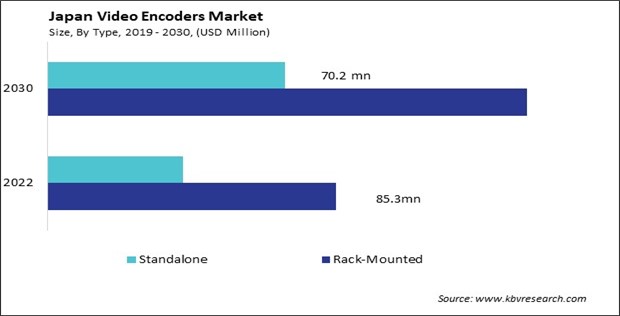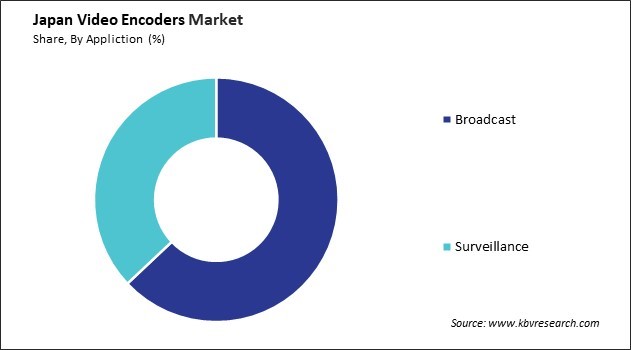The Japan Video Encoders Market size is expected to reach $211.8 million by 2030, rising at a market growth of 6.9% CAGR during the forecast period. In the year 2022, the market attained a volume of 219.7 thousand units, experiencing a growth of 7% (2019-2022).
Japan's push towards digital transformation across industries, including media, telecommunications, healthcare, and manufacturing, has fueled the demand for video encoders. Industries are adopting advanced video encoding technologies to optimize processes, enhance communication, and enable efficient data transmission.

The Ministry of Economy, Trade, and Industry (METI) is proactively promoting digital transformation (DX) in Japan and published the "Digital Transformation" report in 2018. METI warned the local economy would lose $120 billion by 2025 if traditional mainframes and backbone core systems were not updated and the shortage of ICT engineers was not addressed.
Japan provides nationwide access to fast data transmissions via one of the most advanced broadband networks in the world (connected 98.8% of households with FTTH internet lines) and mobile phone service that covers 99.99% of the population. Concurrently, the industrial sector is witnessing an expanding adoption of digital technologies, including ICT solutions, which increase manufacturing site productivity and decrease workloads.
The government intends to proactively advance the notions of "digitalization with no one left behind" and "human-centered digitalization"; these two concepts seek to enhance the quality of diverse services through reforms that prioritize public input and enable individuals to engage in society at their convenience, showcasing their complete creative capacities.
The growth of telemedicine services, coupled with the expansion of e-learning platforms in Japan, necessitates reliable video encoding technologies. Video encoders facilitate the transmission of high-quality video content in these sectors, ensuring clear communication and effective dissemination of educational or healthcare information.
Telemedicine platforms in Japan enable remote consultations between patients and healthcare providers. Companies like M3, a leading medical information service provider, offer virtual platforms connecting patients with doctors for consultations, prescriptions, and follow-ups. Initiatives employing artificial intelligence (AI) for medical diagnostics are emerging. For instance, AI-driven image analysis systems are used for the early detection of diseases like cancer. Companies like Fujifilm and Sony have been investing in AI-powered diagnostic tools for medical imaging.
Various educational institutions in Japan have embraced digital learning platforms. Universities like the University of Tokyo and Waseda University offer online courses covering diverse subjects, allowing students to access quality education remotely. The Japanese government has launched initiatives promoting e-learning. For instance, the Ministry of Education, Culture, Sports, Science and Technology (MEXT) introduced the "e-School Bag" project, providing digital learning materials to students and promoting the use of tablets and e-books in schools.
Japan's growing reliance on telemedicine and e-learning initiatives has significantly influenced the demand for video encoders. These initiatives require video encoding technologies that prioritize high-quality, reliable, scalable, and secure video transmission, shaping the market's demand for more advanced and specialized video encoding solutions.
The entertainment landscape in Japan has been significantly altered by the proliferation of online streaming services, which have introduced a novel era of digital content consumption and varied viewing experiences. One of the significant shifts is the emergence of Over-the-Top (OTT) platforms like Netflix, Amazon Prime Video, and Hulu, offering an extensive array of content encompassing movies, series, anime, and original productions.
Moreover, Japan's rich anime culture has driven the growth of dedicated anime streaming platforms such as Crunchyroll and Funimation. These platforms have garnered a committed user base through the provision of a comprehensive collection of anime series and films. In parallel, the online streaming landscape in Japan encompasses the flourishing domain of live streaming. Platforms like YouTube Live and Twitch have become hubs for creators, gamers, and performers, fostering a vibrant community of live content creators.
Therefore, the popularity of online streaming services for entertainment, gaming, live events, and sports has surged in Japan. These platforms require sophisticated video encoding solutions to deliver high-resolution content efficiently, meeting consumer demands for quality viewing experiences.
In Japan, the adoption of rack-mounted video encoders has surged across diverse industries, reshaping how video content is processed, transmitted, and delivered. The broadcasting and media sectors stand at the forefront of this trend, employing rack-mounted encoders to streamline high-quality content distribution. Companies like NHK, Japan's national broadcaster, utilize these encoders for seamless transmission of high-definition content, ensuring superior viewing experiences for audiences consuming live events, news broadcasts, and entertainment programs.
Moreover, in the realm of telecommunications and healthcare, rack-mounted video encoders have become indispensable. Telemedicine initiatives across Japan leverage these encoders to enable remote consultations and diagnostic services. Institutions like the National Cancer Center Japan utilize high-quality video transmission facilitated by these encoders for telepathology, allowing experts to examine tissue samples remotely, enhancing diagnostic accuracy and efficiency.
Furthermore, in event broadcasting and production, rack-mounted video encoders are instrumental. From sports events like the Olympics to cultural festivals and concerts, these encoders enable the live streaming of high-definition video feeds, providing audiences with real-time, immersive viewing experiences. Thus, the growing use of rack-mounted video encoders in Japan underscores their versatile applications across broadcasting, entertainment, healthcare, corporate settings, education, and event production.

Japan is home to several leading companies in the video encoding industry, contributing significantly to developing and advancing video compression technologies. One prominent player is NEC Corporation, a global technology giant providing various solutions, including video encoding technologies. NEC's video encoding solutions cater to various sectors, from broadcasting and telecommunications to healthcare and beyond, reflecting the company's commitment to innovation and technological excellence.
Another key player in the Japanese video encoding landscape is Media Links. Specializing in media over IP transport solutions, Media Links offers video encoding products that facilitate the efficient and reliable transmission of high-quality video content. The company's solutions find applications in broadcasting, sports, and live event production, addressing the demand for advanced video encoding technologies in the media industry.
A third notable contributor to the video encoding sector in Japan is FOR-A Corporation. Recognized for its video and audio systems, FOR-A provides cutting-edge encoding solutions for broadcasting, production, and post-production environments. The company's encoders support various video formats and compression standards, ensuring compatibility with the diverse needs of the media and entertainment industry.
Furthermore, JVC Kenwood Corporation, a well-established electronics company in Japan, is actively involved in the development of video encoding technologies. JVC's encoding solutions are designed for live streaming, video production, and content creation applications. The company's commitment to delivering high-performance and reliable video encoding products has earned it a reputable position in the industry. As the importance of video encoding continues to grow across sectors such as broadcasting, telecommunications, healthcare, and beyond, Japanese companies are at the forefront of shaping the industry with their advanced solutions.
By Type
By Application
By Number of Channel
Our team of dedicated experts can provide you with attractive expansion opportunities for your business.

